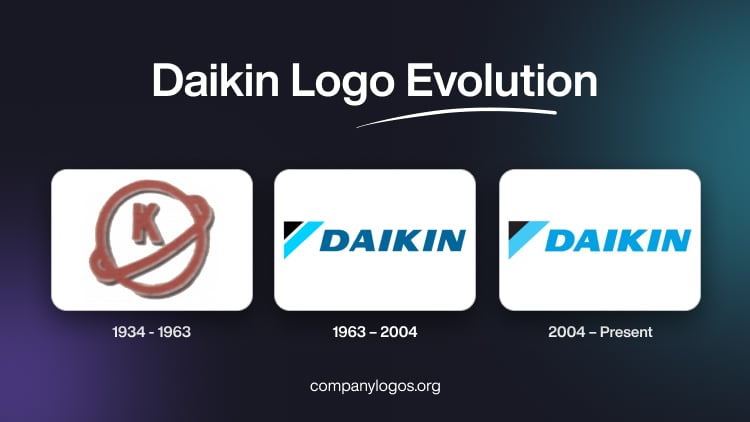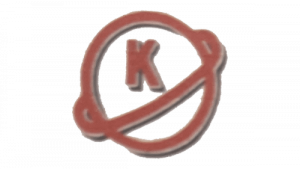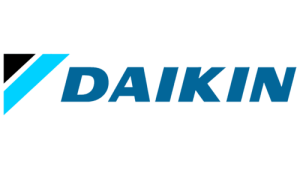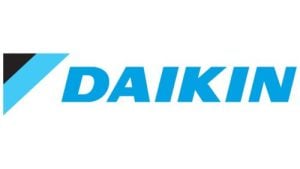
Daikin is a world-renowned Japanese company that produces residential and industrial air conditioners, heating, and ventilation systems. Founded in 1924 by Akira Yamada, the company started as Osaka Kinzoku Kougyou and changed its name to Daikin Industries in 1963. The company also produces smart home solutions, which can be controlled using mobile apps. Besides, the key components used by the company, such as compressors and refrigerants, are produced by it to ensure strict quality control.
The Daikin logo has evolved alongside the company’s growth from a Japanese air conditioning pioneer to a global HVAC leader. This evolution reflects Daikin’s innovative drive and international presence. Its logo incorporates distinctive elements, colour schemes, and a carefully crafted logotype. The article delves into the evolution of the Daikin logo, among other details of the company.
The Genesis of the Daikin Logo (1924 – 1933) (Unavailable)
Daikin began in 1924 as Osaka Kinzoku Kogyosho (OKK) and was into manufacturing aircraft radiators and metal products in Osaka, Japan. In that period, it did not use any standardised modern logo, which reflected its industrial focus.
(1934 – 1963)
The corporate logo of the company (Osaka Kinsoli Kougyuo) was introduced in 1934. It featured a hollow circle with a thick red and silverish-grey outline. There was an orbit surrounding the circle diagonally of the same colour. The circle contained the letter “K” in its top half segment.

(1963 – 2004)
In 1963, the name of the company was changed to Daikin, which necessitated a change in its logo. The new logo featured a black triangle and a sky blue trapezium placed diagonally to the left with a little spacing between them. To its right appeared the italicised wordmark “DAIKIN” in uppercase and using a sans-serif typeface in a deep blue colour.

(2004 – Present)
The current logo does not allow for any spacing between the black triangle and blue trapezium forming the emblem to the left. At the same time, the letters to the right are bold and italicised in a light blue colour.

The Elements of the Daikin Logo
Font
The Daikin logotype in bold, italicised uppercase letters is written using a massive sans-serif typeface with straight glyphs and sharp angles. The similar typefaces are Univers 93 Extra Black Extended Oblique and Nuber Next Black Extended Italic.
Colour
The colour palette of the Daikin logo comprises blue, sky blue, and black, which evokes a sense of freshness and symbolises clean air. Here, if the blue colour is associated with innovation, dreams, and development, the black colour symbolises stability, robustness, and presence.
The History of Daikin
Daikin was founded in 1924 in Osaka, Japan, by Akira Yamada under the name Osaka Kinzoku Kogyosho Ltd. Initially, the company specialised in producing air- and aircraft-related radiator tubes, as well as other cooling-related products. In 1934, the firm pioneered the development of Neoflon, which is a type of fluorocarbon refrigerant. This marked the beginning of Daikin’s long association with refrigeration technology. By 1938, the company officially entered the refrigeration business with its first packaged air conditioner.
After the Second World War, Daikin focused on rebuilding and expanding into new areas of air conditioning and refrigeration. In 1951, it developed Japan’s first packaged air conditioner for commercial use. During the 1960s, Daikin broadened its technological base and created several groundbreaking systems, which included the first multi-split air conditioning system. It allowed multiple indoor units to connect to a single outdoor unit. In 1963, the company officially adopted the name Daikin Kogyo Co., Ltd.
Daikin began expanding globally in the 1970s by establishing subsidiaries and manufacturing bases in the United States, Europe, and Southeast Asia. In 1973, Daikin launched the VRV (Variable Refrigerant Volume) system, which is one of its most influential innovations. It allowed precise temperature control across multiple zones in large buildings. The VRV system revolutionised energy efficiency in HVAC (heating, ventilation, and air conditioning) technology.
By the 1980s and 1990s, Daikin was recognised as a leader in air conditioning worldwide. It also expanded into fluorochemicals and advanced defence systems, thereby diversifying its technological reach.
Daikin has pursued aggressive global expansion in the 21st century. A major milestone was its 2006 acquisition of McQuay International, a U.S.-based HVAC manufacturer. This acquisition strengthened Daikin’s presence in North America. This was followed by the 2012 acquisition of Goodman Global, one of the largest U.S. residential heating and cooling companies. This gave Daikin significant influence in the North American residential market.
Daikin has also focused heavily on sustainability and energy-efficient technologies. It has been at the forefront of promoting R-32 refrigerant, which has a lower environmental impact compared to older refrigerants. Daikin is the world’s largest air conditioning manufacturer that operates in more than 150 countries. It continues to drive innovation in climate solutions, including smart HVAC systems, energy-saving technologies, and environmentally friendly refrigerants.
Interesting Facts About Daikin
- Daikin is the global leader in air conditioning and refrigeration, with operations spanning over 150 countries and manufacturing facilities on every major continent.
- In 1982, Daikin introduced the world’s first Variable Refrigerant Volume (VRV) system, also known as VRF (Variable Refrigerant Flow). This technology revolutionised HVAC by allowing precise temperature control in multiple zones with just one outdoor unit.
- Daikin has been at the forefront of developing environmentally friendly refrigerants. It played a major role in promoting R-32 refrigerant, which has a significantly lower global warming potential (GWP) than traditional refrigerants like R-410A.
- Through its 2012 acquisition of Goodman Global, Daikin became a major force in the U.S. residential HVAC market. Goodman is one of the most recognised names in American heating and cooling systems.
- While best known for air conditioning, Daikin is also a leader in fluorochemicals and has historically contributed to aerospace and defence technologies in Japan.
- Founded in Osaka, Japan, in 1924, Daikin has maintained its headquarters there. At the same time, it employs over 90,000 people worldwide to reflect its global dominance.
- Daikin has pledged to cut greenhouse gas emissions through innovations in HVAC efficiency, refrigerants, and manufacturing practices. In doing so, it has aligned with global sustainability goals.
- Daikin was an early adopter of inverter-driven air conditioning systems, which adjust compressor speed dynamically to save energy and maintain stable indoor temperatures.
- Daikin invests heavily in research and development. Its R&D efforts are among the largest in the HVAC industry and ensure continuous innovation in comfort, efficiency, and environmental responsibility.
- From homes and offices to hospitals, airports, and stadiums, Daikin systems are used in millions of facilities globally.
Finally
The Daikin logo is more about visual consistency rather than frequent redesigns. This stability has reinforced Daikin’s global brand presence as an innovator in air conditioning and HVAC. The colour and form of the logo embody the values of technology, trust, and advancement.